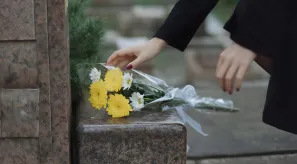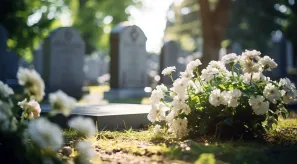When a loved one dies, families face a painful time when they have to comply with a series of legal procedures that not everyone is aware of. At Stelae we explain what to do when a family member dies so that you can face the process after a loss with as much peace of mind as possible.
Steps to follow when a family member dies
There are many steps that must be made when a relative dies. It is also necessary to go to different organisations to carry out these procedures and meet certain deadlines, so it is important to be clear about everything. Here is what to do when a relative dies, step by step:
- Request the medical death certificate. This should be done by the doctor who certifies the death of your relative.
- Register the death in the Civil Registry. This must be done within 24 hours to obtain permission for the burial or cremation of your relative. You will have to present the death certificate and the ID of the deceased.
- Request the death certificate. Once the deceased has been registered at the Civil Registry Office, it is important that you have this document in order to carry out other obligatory procedures. You must do this in person or at the electronic headquarters of the Ministry of Justice.
- Inform Social Security. You have a period of 30 days to notify the death, presenting the death certificate. This procedure is essential if you have to apply for a widow’s or orphan’s pension.
- Request the certificate of last will and testament. You can do this 15 days after the death to find out if the deceased made a will and at which notary's office. You must go in person or online to the Ministry of Justice and fill in form 790, as well as provide the actual death certificate (i.e. original or certified copy).
- Request the insurance certificate. This is done in the same way as the previous procedure and is used to determine whether the deceased had life, death or any other type of insurance.
- Visit the notary. If there is a will, you will have to go to the notary to accept the inheritance or the debts that correspond to you. But what do you do when a family member dies and leaves no will? If there is no will, the notary will have to make a declaration of heirs in order to proceed with the distribution of the possible inheritance.
- Inform the bank. When a person dies, banks usually block their accounts until the heirs can prove that they can manage their money and financial products. To do this, documents such as the will or the declaration of heirs, the death certificate, the certificate of last will and testament, proof of settlement of inheritance tax or the document of division and adjudication of the inherited assets must be presented.
- Cancel or change ownership of contracts and services, such as household supplies (electricity, water, etc). You will also need to change the ownership of the inherited assets.
In addition to all this, there are other procedures to take into account such as obtaining the corresponding pension. And, of course, the funeral procedures themselves cannot be forgotten.
What to do when a family member dies at home
When a family member dies at home from a natural death, the first thing family members should do is call a doctor to certify their death.
Once this has been done, you will have to contact the insurance company of the deceased, if they had one. Otherwise, a funeral company must be contacted to hire their services and have them take care of everything, starting with the transfer of the body to the cemetery or funeral home. They may also take care of some paperwork, such as registering the death in the Civil Registry in order to obtain permission for the burial.
What do you do when a family member dies in the hospital?
If a person dies in a hospital, it is normal for the health centre to provide us with the medical certificate of death so that we can carry out the rest of the formalities. If it does not, we will have to request it.
With this document, the family can start the rest of the procedures, starting with contacting an authorised funeral company who will be responsible for collecting and transferring the body.
What happens if a family member dies and I have no money?
When you have a tight budget when a relative dies, the best option to reduce costs is to opt for a direct cremation.
This service, which we offer at Stelae, involves the cremation of the deceased with no additional costs: no wake, no ceremony, etc.
It is the most affordable alternative when a family member dies. It is quick, simple and more and more families are choosing it, either to save costs or because they prefer a funeral that is as simple and as modest as possible.



